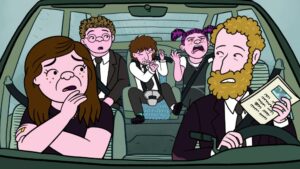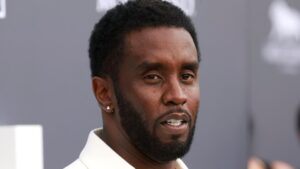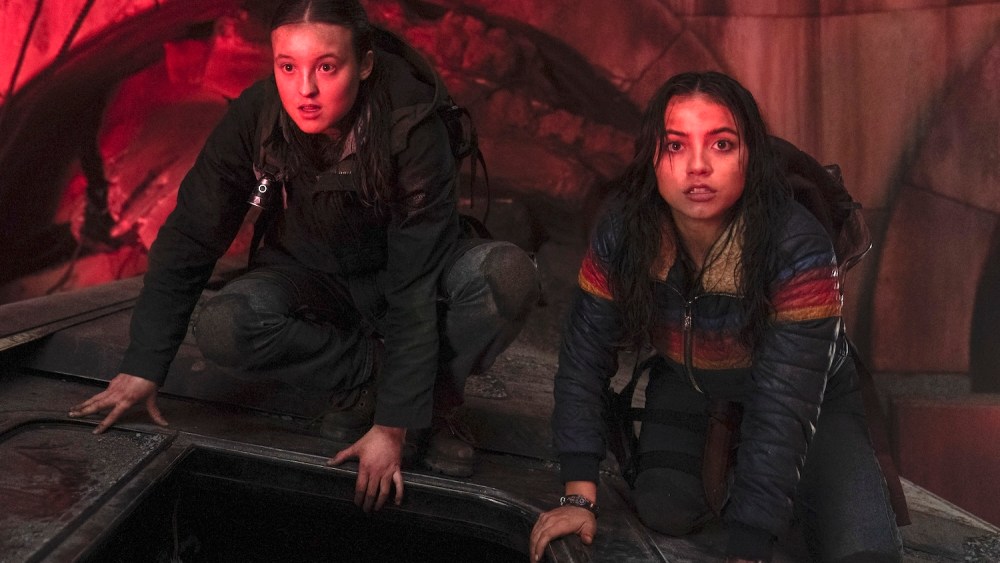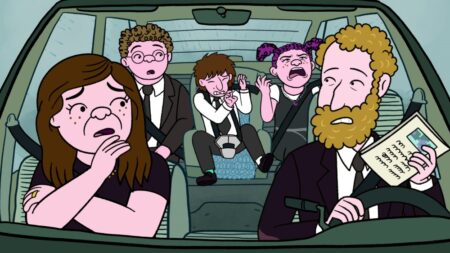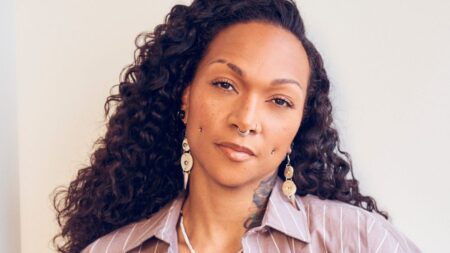SPOILER ALERT: This story contains spoilers from “Day One,” Season 2, Episode 4 of “The Last of Us,” now streaming on Max.
Kate Herron is such a dedicated fan of “The Last of Us,” the video games and their HBO adaptation. So much so that when the “Sex Education” and “Loki” director landed her first meeting with series creators Craig Mazin and Neil Druckmann about helming an episode for Season 2, she nearly showed up on Zoom dressed as the lead character, Ellie (Bella Ramsey). “I was obsessed with it,” she says.
When Herron played the games during the COVID lockdown, they “completely redefined for me what a game could be like,” she says. “It was such a clever exploration of empathy and cycles of violence. I thought the storytelling was some of the best I had experienced in any art form.”
Needless to say, Herron got the job, and the episode she directed is a doozy. In “Day One” Ellie and her best friend Dina (Isabela Merced) start their search through Seattle for the crew of local militia members, known as Wolves, who killed Ellie’s surrogate father, Joel (Pedro Pascal). Over the course of the day, they discover a music shop where Ellie sings a lovely, acoustic rendition of A-ha’s “Take On Me” to Dina; they come across a team of Wolves who’ve been strung up and disemboweled by the extremist religious sect the Seraphites (aka Scars); they’re chased into a subway station teeming with infected, where they have to race through a subway car set upon from both sides; Ellie is bitten, forcing her to reveal to Dina, who’s holding her at gunpoint, that she’s immune to the cordyceps infection; Dina finally confesses her feelings for Ellie and that she’s pregnant; and they consummate their attraction by having sex in an abandoned theater lobby.
Phew! Herron spoke with Variety about how she handled so many different storylines, which also includes the introduction of Wolves commander Isaac (Jeffrey Wright), her deep admiration for how Ramsey and Merced approached scenes with action and intimacy, what it meant to her, as a bisexual, to depict Dina’s bisexuality — and the thing from “The Last of Us” that she’s applying to her upcoming feature adaptation of another wildly popular video game, “The Sims.”
Craig Mazin and Kate Herron on the set of “The Last of Us.”
Liane Hentscher / HBO
What was your relationship to “The Last of Us” as a game and as a show before you got this job?
I was obsessed with it. During lockdown, I bought a PlayStation, and I remember texting my friends, “OK, what should I play?” So I played the first game, and the second game had just come out. It just completely redefined for me what a game could be like, even things like the people that you attack have names. It was such a clever exploration of empathy and cycles of violence. I thought the storytelling was some of the best I had experienced in any art form.
Then I watched the TV show, and I was blown away, so when they were doing the second season, I was like, I have to see if they’ll meet me. I mean, look, I almost dressed as Ellie for my Zoom meeting. I remember showing them I had a vinyl of the music from the game and the TV show. I was so nervous, I was really early, and Neil was also early, so I had this moment to talk to Neil before everyone else joined the call. And I remember thinking, “You know what, if I don’t get this job, at least I got to talk to Neil Druckmann.”
It’s very different to other stuff I’ve done. I tend to do drama-comedy, so it was fun for me as a challenge to really dig my teeth into something that was a heavier.
Once you got the job, what were the central things you talked with Craig and Neil about?
For Episode 4, the key needle to thread is Ellie and Dina’s relationship. And also this episode is really starting us out on this path in Seattle. They are working out that they have entered into the middle of this conflict and that the people are just as dangerous, if not more dangerous to them, than the infected. And most key is that Abby is part of something much larger, which Ellie and Dina do not understand going into this at all.
How did you want to approach Ellie and Dina finally acting on their feelings for each other?
You don’t often get moments to give characters a breath or relief, which is so important here, like in the music shop in Seattle. Who hasn’t wanted to play a song to their crush? Just getting to see them joking as they’re going through the streets, it was really important for me to remember, in spite of it all, these are two very young people in a terrible situation.
Also, it was important that people wouldn’t necessarily be able to guess that Dina does actually have feelings for Ellie. In the music shop, they do have this great chemistry, but when Dina thinks Ellie is infected, she doesn’t know about Ellie’s immunity. So it was really important that we were afraid for Ellie in that moment, right up until the point of the kiss.
What were you focused on for the sequence in the theater, from Dina holding Ellie at gunpoint to them having sex for the first time?
We spoke a lot about the emotion of it — what level should Ellie be at? The answer is very afraid and very worried — we need to feel Ellie is in danger in that moment. Ellie doesn’t know what Dina wants from her. Most of our conversations were about the emotional arc of it.
As you said, the actors worked with an intimacy coordinator, and you’re familiar with on-screen intimacy given your experience directing “Sex Education.” But was there anything about shooting that particular scene that was a discovery for you?
I was blown away by Bella and Izzy, just within their performances. Bella is one of the best actors I’ve worked with, for sure. They just have this well of energy. Izzy is incredible; you could be filming at 3 am, and Izzy would make a joke and lift everyone’s spirits. There’s just this determination and focus between them both. I got them already deep into a shoot, and they’re in nearly every scene, and I was asking them to run through subway tunnels and be in the rain. When you watch that in an episode, it’s all compressed into this hour, but you’re filming those moments every day for a month.
The next morning, Dina talks about how she’d told her mother when she was younger that she likes boys and girls, and her mom told her she just liked boys. There still aren’t that many examples of bisexuality expressed so matter of factly. Was that part of your attraction to this particular episode?
Truthfully, I was already on board, and then they told me which episode I was going to be doing. I hope Dina’s story will connect with a lot of people. That’s the joy of the game and the joy of this TV show. You don’t often see queer stories told on a level this big. Quite often, it’s in very niche media. There are exceptions, and “The Last of Us” is one of those exceptions.
The sequence of events from the TV station through the subway tunnels is roughly the same in the game, but it’s so different visually. In the game, the station is in the bright sunlight, and the subway tunnel experience takes a lot longer, and isn’t quite as intense. How did you approach adapting the visuals from the game to the show for those sequences?
The change from day to night was in the script, but I thought it was brilliant. That’s so much scarier. But for me, the most important thing with any adaptation is remembering how the game made me feel, and I remember being terrified and tense in the TV station and the subway. I was planning that [sequence] while everyone was away filming Episode 2, so I was just on my own in the office. I’m really happy that we got to heighten it to that level and make it a true nightmare. It has to be, because when you get to the theater, you need to be building on a scale to get to the point where Dina is holding a gun at Ellie.
Isabela told Variety that the subway cars were really rocking when the infected were attacking it. How difficult is that to shoot, when you’re in something moving around so much like that?
I was honestly having the time of my life, hanging onto the subway. I grew up in London, so I was like, this is just like being on the Underground, or a very badly driven bus. Within the realm of everyone’s safety, if you can put the actors and everyone filming into that position and it works, then it can only add, you know? We have incredible stunt actors in this show, and they were really coming through the windows and trying to grab them.
Let’s talk about Isaac. Jeffrey Wright also played that character in the video game. Did that shift how you approached directing him?
I love Jeffrey as an actor. I mean, I always go in with respect for any actor, but yes, I’m not going to tell Jeffrey extensive things about a character that he’s already played and knows so well. It was just really important to be there with him in those scenes. Does this feel emotionally true? Why don’t we try this and just make sure that we had different options?
Even for people who have played the game, the opening scene with the FEDRA soldiers is disorienting, since there’s no one who’s familiar on screen at first. What kind of challenge is that for you as a director to ensure that the audience isn’t totally thrown off?
The real key thing there is that we have this rookie [played by Ben Ahlers], who, yes, knows a bit more than the audience knows, but they’re on the back foot and trying to work out how they feel in this world. It’s about POV, putting you with the rookie from the beginning, because it feeds into the bigger theme of the show, which is about choice. But I think it’s OK that the audience has questions. “OK, who exactly are these people? Who is Isaac?” Because we are going to gradually tell you more and more.
Isaac torturing the naked Seraphite (Ryan Masson) is such an intense sequence to watch — what was it like for work on? How do you direct somebody who is so exposed and vulnerable and beaten down?
We had intimacy coordinator that day with us to check in with everyone, especially our actor, to make sure that everyone was feeling OK. The role was always written as naked in the script, so that was a conversation when we were casting. Our actor was very comfortable, but yes, it is a very heavy scene. It’s just about directing it with compassion. Isaac has done a terrible thing to this person, and that is important to see.
Finally, how far along are you with making a feature film adaptation of “The Sims”?
I’m just writing away, but we’re all feeling very good about it.
That game could scarcely be more different than “The Last of Us,” but have you taken anything from your experience on this show that you’re that you’re bringing to the movie?
It’s tricky to know what I can say, but I’m very indebted to Craig and Neil for giving me an opportunity to direct on it. Getting to do that was like a bucket list kind of moment. I just hope I get better at my job. OK, actually, I’ve got a much better answer for you. I’ll answer it again. Craig writes the thoughts of the characters in the script. I love it, and I have 100% stolen that, and I’m now doing it in all the scripts I write. It’s such a good idea.
This interview has been edited and condensed.
Read the full article here

